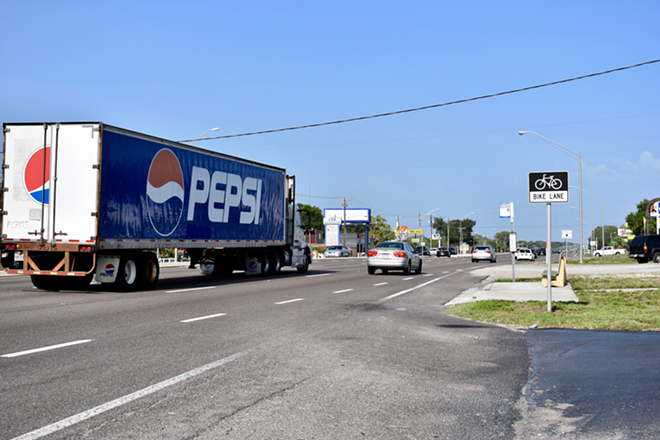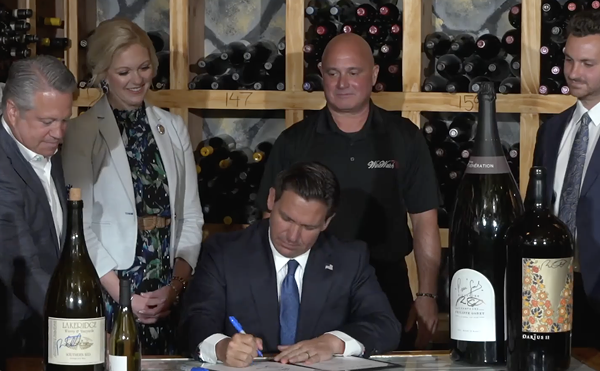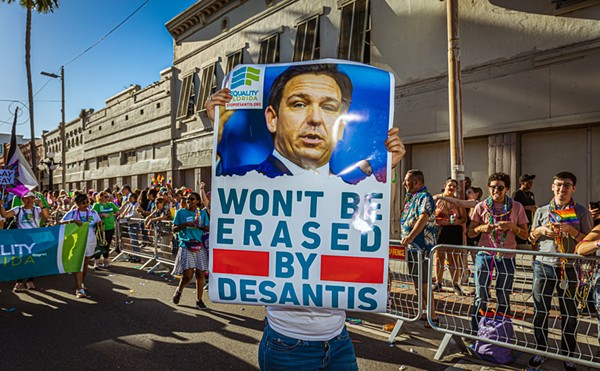
Fowler Avenue is a six to eight-lane concrete slab that few would describe as safe, let alone charming. Situated between I-275 and I-75, Fowler runs along some of Tampa’s big-name employers, including the University of South Florida. Drivers heading east from I-275 pass budget hotels, gas stations, parking lots and strip malls. Pedestrians roast in the mostly unshaded sidewalks separated from the road by overgrown ditches. Crosswalks are few and far between. Alongside the ditches and the traffic that rarely observes the 45-50 MPH speed limits, cyclists pedal down a bike lane separated from cars by nothing more than a white painted line.
One of Hillsborough County’s most dangerous roads, Fowler Avenue is far from supportive of the growing population of people, especially those looking to get around without a car. Last year, three cyclists and one pedestrian were injured in automobile accidents on the nearly two-mile span of Fowler that runs in front of USF. That figure doesn’t include any injuries incurred on the remaining six miles of Fowler’s eight-mile stretch. The locale is hardly attractive for the growing population of people who’d rather walk or bike than drive.
Whereas many people are moving to walkable, bikeable neighborhoods, Mark Sharpe did the opposite: he moved to the area surrounding Fowler Avenue and USF for first-hand experience with its shoddy transportation infrastructure.
Why?
Because Sharpe, the executive director of Tampa Innovation Alliance and a former Hillsborough County Commissioner, thinks a transportation revamp for Fowler Avenue and the university area could breathe life into what he describes as Tampa's “innovation corridor.” And what better a way to figure out how to fix dangerous, unsettling roadways than to live the life of someone who has to walk, bike or ride them on a daily basis?
“I believe in immersion. When you try to change something you immerse yourself into it so for seven months I moved into the district to really immerse myself in it, what it feels like to wake up and go to bed at night in the innovation district,” he told CL.
Multimodal transportation is the key to tapping the USF area’s economic promise, said Sharpe.
“If I could unleash the potential of that area by creating a system of enabling short trips, we will transform not only the university area, but ultimately all of Tampa Bay," he said. "And we are going to create a vibrant regional economy which is going to assist the state and generate the jobs necessary to support our growth.”
Tampa Innovation Alliance is working with a team of organizations, including the Hillsborough County MPO and the Florida Department of Transportation, to put together a proposal to slow down and spruce up Fowler Avenue, making it more accessible for people who live and work in the area.
So far Sharpe has walked, bussed and used rideshares in the area, but he hasn’t yet biked.
“Being on foot is scary, crossing a street is scary — even when you have the cross signal. Riding a bike is very scary,” he said about navigating Fowler Avenue. You can read more of his reflections on Tampa’s transit in pieces he penned for CL in April and May of this year. Despite the danger, Sharpe still plans to take up commuter cycling at some point in the near future.
Bike riders who dare to ride Fowler run the risk of tangling with cars, but the thoroughfare remains a necessary and dangerous evil. Austin Gibble commutes by bike to University of South Florida, where he works as a graduate research assistant. Gibble said he takes alternative routes when cycling, but “there are some places I’d like to get to that are along Fowler that are difficult to get to by bike so I have to drive and I hate driving.”
The hassle and cost of cars are driving people like Gibble to use alternative forms of transportation. Across the U.S., fewer people are getting driver’s licenses, and between 2014-2016 there were fewer motor vehicle registered in Hillsborough County. Yet Tampa Bay’s transportation infrastructure is notorious as one of the most dangerous and dysfunctional in the country, particularly for cyclists and pedestrians.
The proposal to redesign Fowler Avenue is part of a greater initiative to make the Tampa Bay area roads safe and accessible for people of all ages and abilities, regardless of whether they’re on a bus, in a car, on foot or on a bike. By lowering speed limits, planting trees, widening sidewalks and constructing partitioned bike lanes on Fowler, officials would transform the heavily trafficked road into a so-called complete street, a term used to describe a road with elements that support multimodal forms of transportation.
Both Tampa and St. Petersburg are outfitting problematic roads as complete streets. In May the Florida Consumer Action network reported that complete streets result in an 18% decrease in roadway accidents, a 23% increase in walking trips and a 50% increase in bicycling trips.
Protected bike lanes are a particularly important part of a complete street design because they offer a path for a safe and efficient commute, said FCAN representative Lisa Frank.
“The data’s really clear that people bike to work more in cities with more bike paths...getting our street design right can give everybody moving around the city more options and make sure everybody gets there safely," she said.
Complete streets infrastructure may increase cyclist safety, but poorly designed roads aren’t the only threat to riders. Ornery drivers are known to menace people on bikes. Gibble said he observes the rules of the road and steers clear of cars, but that doesn’t always spare him harassment.
“I can be one-hundred percent visible, following rules of the road, using hand signals but because a driver has to move their wheel to the right or left for ten seconds they’ll get furious,” said Gibble. “I’ll get yelled at, cussed at, things thrown out the window.”
Cyclists like Gibble long for the day they can bike in the USF area without fear of mortal doom. Meanwhile drivers long for the day they can drive in the area without suffocating traffic, and pedestrians long for they day they can cross area roads without playing human Frogger.
The proposed Fowler Avenue facelift could be the solution, but it’s not a quick fix. Sharpe said the project won’t happen without the “wholehearted support of FDOT” and it could take between six to ten years to implement.
















